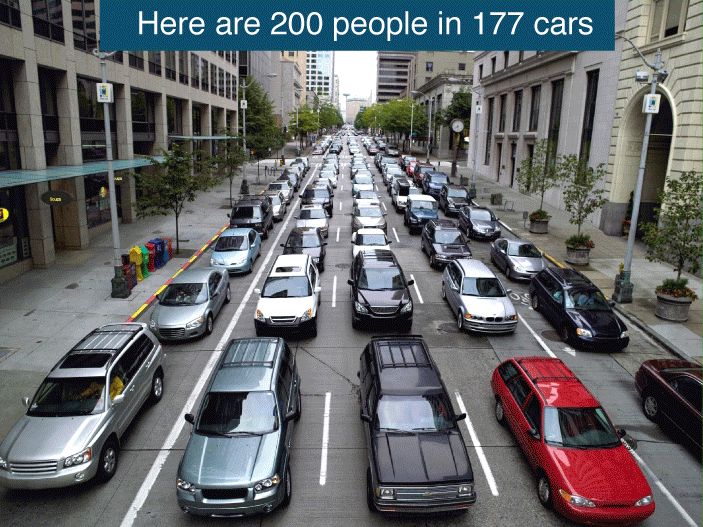Public Transit and the Fallacy of Induced Demand
This article is one of many that appear on the Strong Towns blog (well worth reading) and they mention the concept of ‘induced demand’ for public transit.
They use this image as a key reminder about the impact our decisions have on congestion:

It’s a great image.
Unfortunately, it’s horse shit.
For starters, I commonly see this GIF used to support encouraging municipalities everywhere to spend public money on bus infrastructure. I understand the basic math associated with the image showing single people in 200 cars, but let’s not overlook the fact that too frequently, large buses service too many routes for too few people, especially in smaller towns. Obviously, this experience may be different in larger cities.
I accept the premise related to induced demand, but also remind readers to reflect on the comments and economics associated with Giffen goods (ie. inelastic demand associated with goods that people have a vested interest to use, ie. cars that they own).
Demand does not simply *shift* from one mode of transportation (private car use) to another (public buses), assuming the second option (public transit) gets them from ‘A to B’ in the same amount of time.
This is because many consumers are faced basically duplicating their cost. A car is a sunk cost, representing the need to be used before consumers will consider another service. It’s easy to assume that most commuters (again, outside major urban areas that have effective public transit) will have a car. Adding bus fare to their costs may not be a feasible economic option.
Also, I’m a data nerd. In order to justify public investment in transit infrastructure, especially buses, we need to aggressively track the use of public services and record on their popularity. Test before invest. This is what private companies do when launching new products. We need to do more in the public before forcing everyone to jostle around cumbersome, unused buses.
If we show that single routes don’t get riders, we need to understand why before dumping public money into the ‘if we build it, they will come’ mindset.
Finally, I’ve mentioned this before on this blog, but the ‘big bus’ mindset may have to disappear in favour of new ideas. The weight of these vehicles are destroying road infrastructure faster than passenger cars and we need to consider at least five things as we build public transportation infrastructure:
- Trains first. Always. A separate infrastructure results in separate load requirements.
- Smaller buses, especially for connecting routes.
- Private-public partnerships, including creative alliances with ride-sharing programs.
- Better planning related to pedestrian and cyclist routes (and not making them secondary considerations to road construction). We need to separate cars/trucks from non-car commuters.
- Encouraging ‘work from home’ or the development of smaller, regional economic nodes that ease the burden on commuting.
I conclude with the common ‘I believe in public transit’ statement because, well, I do. Using cars twice a day to sit in parking lots the rest of the time is a complete, foolish and irresponsible waste of resources for the owners and for the public.
Also, the duplication of expense points to one simple solution:
PUBLIC TRANSIT SHOULD BE FREE.
We do this for health care and many food programs. We should do it for public transportation.
When the cost consideration is removed, especially for those who need it most, we don’t have to make assumptions about use. It will exist.